Lost in Translation: The Sounds of Silence
Sofia Coppola’s Lost in Translation has quite a lot to say for a film that, with its title alone, conveys themes of miscommunication and disconnection. Themes of loneliness and isolation abound. How does Sofia Coppola achieve this? The sound design of a film is important to think about when considering the film’s overall effect on the audience. Lost in Translation pays particular attention to silence and sound in order to communicate underlying feelings of alienation, anxiety, or (conversely) comfort and intimacy.

Language Barrier: Culture Shock
The obvious obstacle presented in Lost in Translation is language. As Americans stranded in Japan on business, both Bob and Charlotte have many new culture shocks and differences in custom to contend with. Bob seems to be trying to resurrect a lagging career while Charlotte is simply tagging along with her husband on a business trip. Despite the exotic new destination, Japan does not exactly inspire them toward adventure and a renewed sense of energy and purpose.
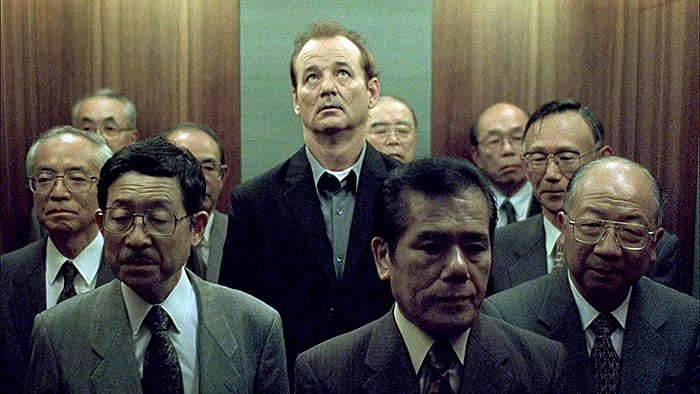
Instead, the differences between them and the locals becomes exceedingly apparent. Bob towers over the other men in the elevator. He has to stoop over to take a decent shower. When shooting commercials, Bob struggles to appease directors or engage in witty banter with photographers. Long and seemingly elaborate directions in Japanese are translated into succinct and truncated English. His allusions to Sean Connery are transformed into Roger Moore instead.
Unless one speaks Japanese, the audience is just as lost as Bob is. English subtitles are never provided so that the audience can never have the possibility of one-upmanship. Despite trying to inject some levity into the situation and trying his best to appease the directors, Bob finds himself unable to bridge the gap.
Being a blonde, Charlotte especially stands out in a sea of dark-haired individuals. Whenever she decides to go out and engage with her new surroundings, she is always on the outside looking in. Whether she sees people caring for bonsai trees or views the activity in an arcade game center, it only serves as a reminder to the audience that Charlotte is merely a spectator. She acts as perhaps a placeholder for the film’s audience, able to view the excitement and beauty displayed on the screen but held at an impersonal distance.
Since Japan is such a densely populated country, it amplifies the feeling of being “lost at sea.” In a city like Tokyo, much like New York City, one is anonymous and unrelated to his fellow man. It is bright and flashy and full of activity. Yet all this liveliness can exacerbate feelings of disconnectedness in people who already feel they are not a part of the community there. It contributes to the overwhelming feeling of being surrounded by people and yet feeling utterly alone.
Even in a place like Kyoto, where Charlotte briefly escapes to, this loneliness persists. Kyoto is noticeably calmer in atmosphere than Tokyo is. This appears to alleviate some of Charlotte’s anxieties. The film captures Charlotte commuting by train, watching a traditional Japanese wedding, and attaching a wish to a tree already laden with many bits of white paper. Every act of Charlotte’s in this scene is done so in silence, likely to illustrate the religious profundity of this moment. However, not even the seemingly sacred Kyoto itself is silent. The noise of the train station, schoolgirls chatting among themselves, and birds chirping is captured alongside a delicate instrumental track the film provides. Kyoto may be muted, but it is alive. Only Charlotte is not quite a part of it yet. She is still alone.
Bypassing Language: Initial Encounter
Being native English speakers certainly helps Bob and Charlotte make a quick connection with each other. However, Bob and Charlotte also find ways to bypass spoken language as well. Much of their connection is illustrated by silence, an established understanding, as well.
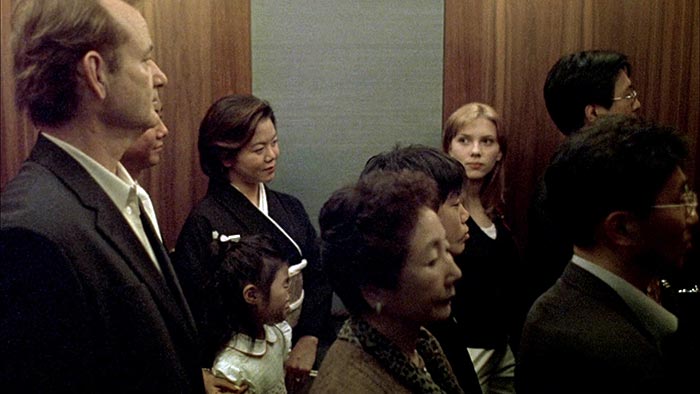
Their “meet-cute” is neither an official meeting nor “cute” in the usual sense. There is no spilled coffee or dropped textbooks strewn along the sidewalk. It is utterly ordinary and unremarkable. Two people stuck in a crowded elevator briefly make eye contact with each other and smile before returning to business as usual. It is a meeting so seemingly inconsequential that only Bob remembers it, while Charlotte only remembers their “official” first meeting at the bar.
In a reversal of the typical gender-based expectations, it is Charlotte who sends over a drink to Bob at the bar. Her forwardness likely catches him off guard, though he is visibly grateful for the kind gesture. He gives her a nod of acknowledgement, which she returns before he departs.
It takes several unfinished run-ins with each other before they finally begin to embark on a beautiful friendship together. Their relationship exists via karaoke songs, elevator glances, and notes sent via fax machines. Nothing too elaborate or charming needs to be said for one to impress the other. The bond exists in the fragile pauses of silence. They meet each other in this small pocket of unproductive time where they feel lost in their personal lives. Perhaps they would not have found or even noticed each other had this gap of space and time not existed. The fireworks and light-bulb moment of a “love at first sight” are for Hollywood fictions. Bob and Charlotte’s connection is a far subtler, subdued affair. Repeated glances and fresh perspectives, brought about by multiple meetings and induced by a change of location, are needed to kindle a fire rather than ignite a spark.
Enlisting Comedy to Defeat Tragedy
Humor is another manner in which they bypass traditional communication. Charlotte has a piercing, dry sense of humor masking her sensitive spirit. Despite the fact that Bill Murray is a comedian in real life, it is Bill Murray’s Bob who often ends up being a punching bag to Charlotte’s sharp digs.
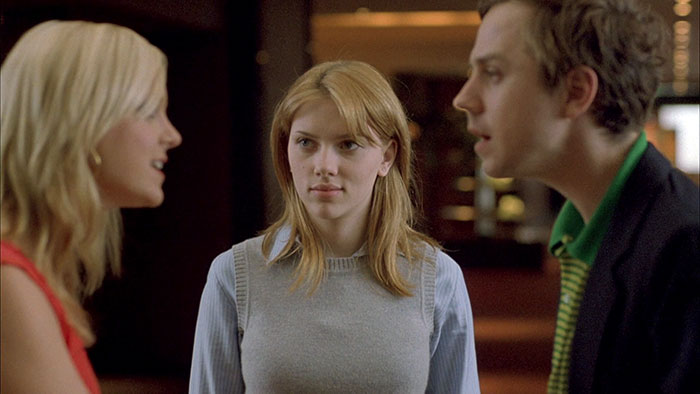
As a former philosophy student, Charlotte appears to have a keen intellect. She doesn’t easily tolerate anyone she considers too superficial. This includes her husband John’s actress acquaintance, Kelly. Kelly is bubbly and unrestrained in her topic of conversation, which can include her bad body odor one day and her father’s alleged eating disorder the next. Though John does not exactly seem to love her company either, he refrains from deriding her. However, Charlotte’s attention is not readily available to just anyone. As her level of tolerance diminishes, her sense of isolation grows.
Bob wisely combats Charlotte’ demeanor by being playful. He often uses a self-deprecating tone to go along with the jokes she makes at his expense. This softens the blow and renders any, however unintentional, attack useless. This is not to suggest Bob is a pushover. While Charlotte’s husband John consistently calls out her behavior, Bob chooses not to take what she says to heart.
Charlotte: “You’re probably just having a mid-life crisis. Did you buy a Porsche yet?
Bob: “You know . . . I was thinking about buying a Porsche.”
Charlotte frequently makes jabs concerning Bob’s age, but Bob often deploys a gentler sense of humor in return. When Charlotte needs her foot x-rayed after stubbing her toe a few days earlier, Bob looks after her with a paternal warmth. He makes several jokes about the severity of her condition, exaggerating her injury to the point of unlikelihood but never once mocking her personally. This “gallows humor” likely helps alleviate any anxiety she might have. Only Bob and Charlotte can participate in this humor. Whether they are at the restaurant or at the emergency hospital together, these little conversations are always “inside jokes” that only the two of them share.
Bob: “That toe is almost dead. I think I’ve gotta take you to the doctor. You can’t just put that back in the shoe.”
Charlotte: “No, I don’t think so.”
Bob: “Well, you either go to a doctor or you leave it here. He’s smiling. (addresses chef) You like that idea? (turns back to Charlotte) See, they love ‘black toe’ over in this country. (addresses chef again) You got a sharp knife? . . . We should probably hang around until someone orders it?”
Humor is used to discuss taboo subjects, to expose or at least poke fun at uncomfortable truths, but the witty banter Bob and Charlotte engage in is also used to disguise one’s true feelings. Bob and Charlotte only rarely discuss their real sense of unhappiness and what this new friendship means to them. As if to preserve the sacredness of this time, Bob and Charlotte rarely acknowledge the limited amount of time they have left together. Soon after their only recorded fight in the film, Charlotte openly acknowledges how terrible it felt. Bob attempts to recover their old rapport by acting as though it was the restaurant that was the problem and not an internal flaw in their relationship, a move which immediately puts their relationship back on track again.
Charlotte: “That was the worst lunch.”
Bob: “So bad. What kind of restaurant makes you cook your own food?”
Charlotte: “When are you leaving?”
Bob: “Tomorrow.”
Charlotte: “I’ll miss you.”
One night where they meet up in his room to watch some late-night T.V., she acknowledges she thought he looked “quite dashing” the first time she saw him in the bar. On the night before their separation, Charlotte asks Bob not to leave before jokingly suggesting they “start a jazz band” together. Charlotte fleetingly expresses she’ll “miss” him again before giving a curt and unusually formal goodbye the morning of Bob’s departure. Yet it is apparent when Bob attempts to repair this broken goodbye and transform it into its proper form, that Charlotte is heartbroken by their imminent separation. She has tears in her eyes and can barely say a word to him. She seems incredibly happy at his return. He didn’t give up on her simply because she seemingly rebuffed him. He knew that wasn’t the “real” her, or at least the one that matters.
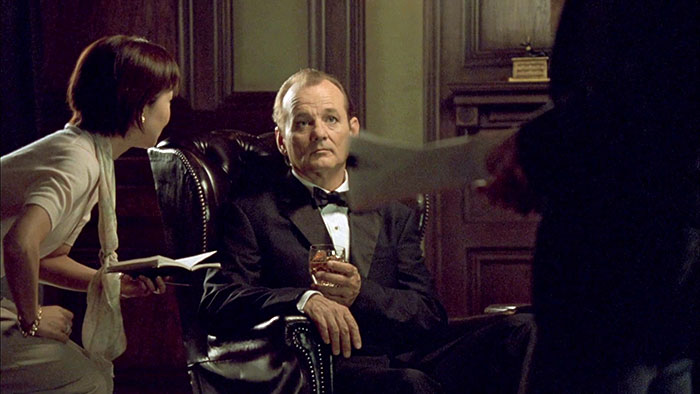
Both Bob and Charlotte are related to the movie-making business in some capacity. As a Hollywood actor, Bob is all too aware of the illusion, trickery, and manipulation involved in the entertainment business. Charlotte’s husband John is a celebrity photographer who frequently works with those in the media industry. Both Bob and Charlotte are aware of these dream-making enterprises which specialize in heightening reality into a more idealized form. As the saying goes, a good film or a good book is simply life with all the “boring parts” taken out. At times, this endeavor can seem phony or artificial. Sometimes it is. But in the case of Bob and Charlotte’s friendship, the lifting oneself out of the monotony of day-to-day life serves to impact them both in a meaningful way. Their friendship, though a heightened experience itself, is nonetheless real.
Tag Team
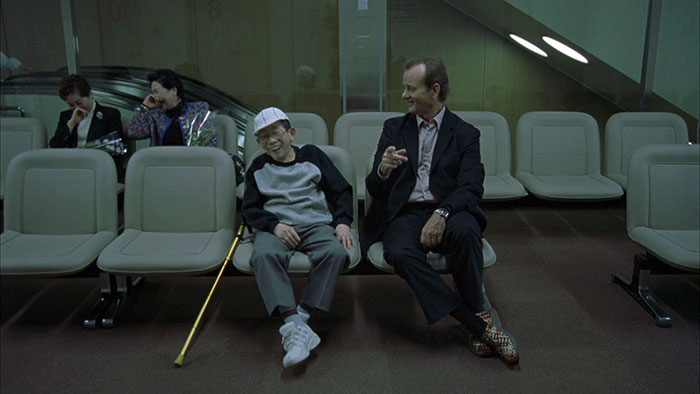
Once Bob and Charlotte become a team, the language barrier appears far less daunting than when it is faced alone. They manage to go to the hospital, order food, and mingle at parties. All of this is seemingly accomplished with ease. Though there are obviously miscommunications and gaps in understanding, none of it seems fatal. They can laugh it off.
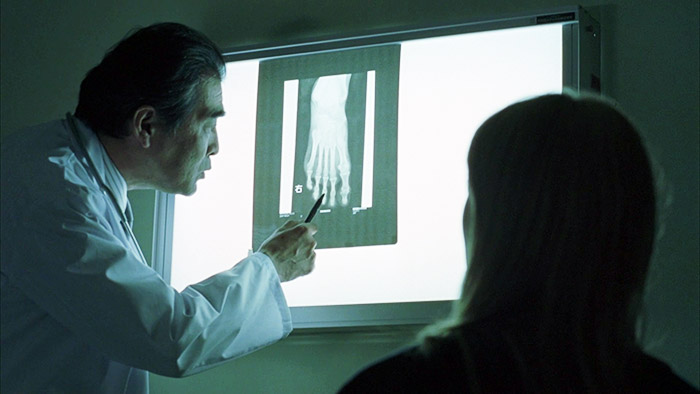
Bob has more successful conversations at the bar. He can chat with the locals at a noisy club, despite their obvious broken English. He can make light banter with a patient in the hospital waiting area. He seems suddenly unperturbed by the threat of miscommunication. Charlotte doesn’t lose her toe just because she can’t understand the doctor who x-rayed her bruised foot. The feeling of connection empowers individuals to face obstacles they might otherwise struggle to face on their own.
And yet when Bob and Charlotte are with each other, language is brave in another way. The most profound moments they share with each other are ones in silence. Charlotte rests her head on his shoulder after a night out with friends. Bob carries a sleeping Charlotte back to her room and tucks her in bed before leaving. Bob and Charlotte look into each other’s eyes, holding each other’s hand, while contemplating Bob’s departure the next day.
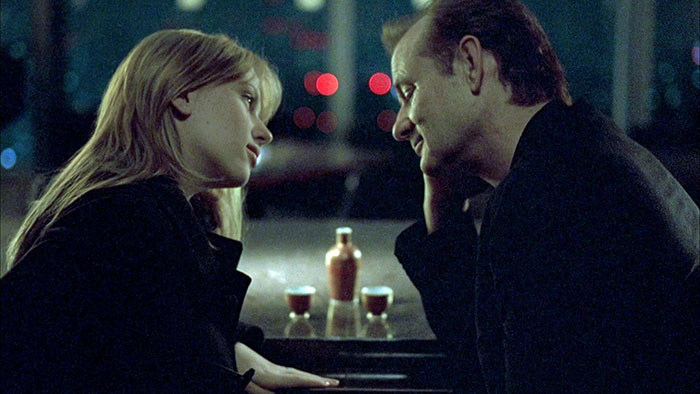
Lost Worlds: Broken Relationships
After examining what Bob and Charlotte have together, it is worth looking back at the conditions they have already been saddled with from the beginning of the film. First, one might look at the disparate depictions of Bob and Charlotte’s marriages. Charlotte is relatively inexperienced when it comes to married life, having only been John’s wife for two years. Bob, on the other hand, is well past the training wheels stage of matrimony at twenty-five years of marriage.
Charlotte’s scenes with her husband are limited. As soon as they are together, he is usually shown hustling over to some new photography job or meeting. He is the busy spouse with little time to talk and relax. Charlotte is repeatedly shown trying to initiate emotional intimacy with a man who seems more concerned with advancing his career than tending to his relationships. She wants to spend time with him, but he always seems to be too busy to spend quality time with her. Whenever they do spend time with each other, it is often interrupted or is included as part of his “work time.” When she gently and indirectly pleads with him to choose her over his work for one day, he goes to comfort her but ultimately ends up saying she’ll be fine without him for a little bit. Charlotte politely smiles and goes along with her husband’s suggestion. Though he clearly cares for her, John seems distinctly unaware of her loneliness and does little to help lessen it with his own actions.
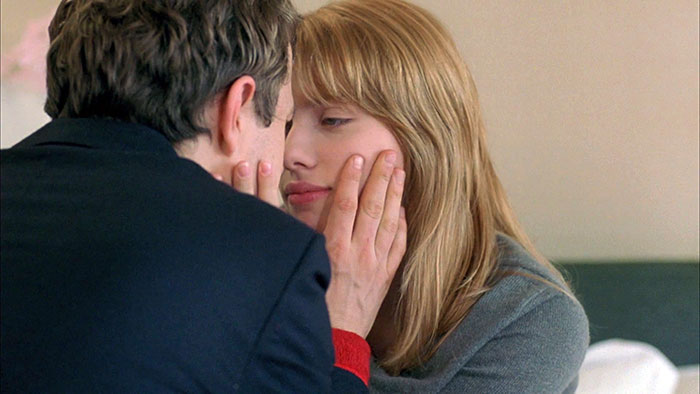
The only time Charlotte ever really has her husband all to herself is at night, when they’re sleeping together in their hotel room. Yet not even this space serves to connect them. While John is shown happily sleeping peacefully and snoring to his heart’s content, Charlotte is restless and awake (her insomnia not likely aided by her husband’s loud snoring). Charlotte is shown reaching out for the comfort of her husband in the middle of the night, illustrating the mixed signals these two are sending to each other. The audience can clearly observe Charlotte wants to have a conversation while John just wants to snuggle while trying to catch some z’s.
When Charlotte calls a friend back home, the telephone is shown as another vehicle for two people to connect (or not) with each other. Unlike texting, phone calls at least provide the listener with the actual voice of the person on the other end of the line. Even though it is a disembodied voice (and thus body language is removed from the exchange), vocal inflection and tone are still detectable. However, Lost in Translation shows this is still not enough for two people to necessarily truly understand each other. A phone call does little to help Charlotte in her moment of emotional need. Though Charlotte proclaims what a cool place Japan is and how happy she is there, the trembling and quivering in her voice tell an entirely different story.
“It’s great. It’s really great here. I don’t know . . . I went to this shrine today and um . . . there were these monks and they were chanting and I didn’t feel anything. You know?”
Charlotte
In fact, her friend would not even have to rely on nonverbal cues at all. During their conversation, Charlotte explicitly lets slip that she feels “nothing” there in Japan. Her friend does not appear to register her distress and unhappiness whatsoever. She breaks away from the phone to take care of something else only to return and ask Charlotte to repeat herself, as though she merely interrupted a report of tomorrow’s weather forecast.
The audience is in the privileged position of being able to witness Charlotte fully during this emotionally vulnerable moment, unimpeded by a lack of visual cues as her friend is. Viewers can easily watch the gradual disintegration of Charlotte’s confident exterior in just a few minutes of this exchange with someone who is supposedly privy to her interior world. Yet the film audience obviously has the physical screen barrier to contend with and cannot hope to comfort Charlotte either. Viewers are forced to watch Charlotte attempt to compose herself all on her own. From then on, viewers are aware of the thin shell that insulates one human’s pain from another’s. It is a battle each individual faces alone every day and one that never seems to end.
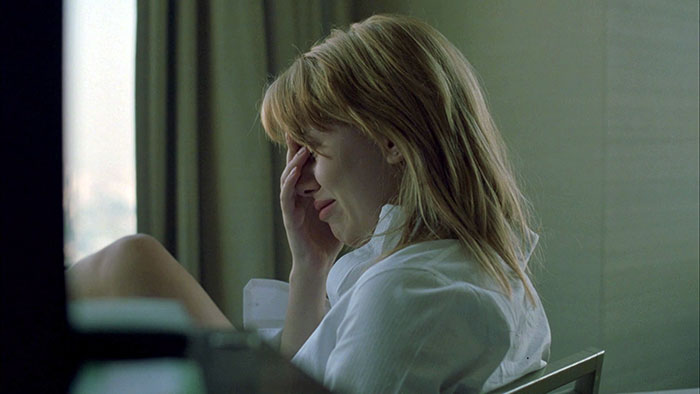
There are mentions of Charlotte’s friends in Japan. They appear not just by word of mouth to the viewer, but appear physically onscreen as well. And yet the term “friend” seems to be used lightly here. They seem to simply be people she knows. She knows their names. She hangs out with them. She goes to parties with them. Yet they do not seem to know her well at all as a person. Since the audience is mainly accustomed to seeing Charlotte alone, they are aware the term “friend” is used lightly here.
Let’s look at Bob’s relationships. To the viewer, Bob’s interactions with his family are mainly one-sided interactions. Viewers never see what his wife or their children look like. They are disembodied voices on the other end of the phone much like Charlotte’s friend back home. They are distant characters with far-away voices. In this way, Bob’s wife and kids make little impact in the viewer’s mind. In fact, their inconsequential nature threatens to disturb the fragility of Bob and Charlotte’s relationship, which exists in this small bubble of onscreen time and space that viewers have come to regard as the only reality there is.
As two people who have progressed further into the their marriage than Charlotte and her husband have, Bob and his wife are slightly more separate entities. They have their own lives and will not wither away and die if separated for too long. With the addition of their kids, Bob’s wife doesn’t feel the need to tag along with him for every business trip he makes in some remote location. It’s okay for them to spend some time apart. It’s not considered the end of the world.
Bob’s wife also finds ample opportunity to deliver subtle jabs in her late night faxes. She reminds him of how he forgot Adam’s (presumably one of their kids) birthday and how she can spend some “quality time” with the construction crew now that he’s gone. These statements seem to be meant as tongue-in-cheek quips made at his expense. They are not done out of malice and yet they perhaps point to a larger issue running through their marriage. No matter the wit behind them, these exist as incessant reminders of perceived faults which are bound to drag a sense of intimacy and hopefulness down with it. And without the face-to-face interaction to coincide with the words, the sting of them feels sharper and the intent behind them remains mysterious. Moments of lightheartedness and forgetfulness, something Bob and Charlotte engage in with each other, are necessary to keep the healthiness of a relationships going.
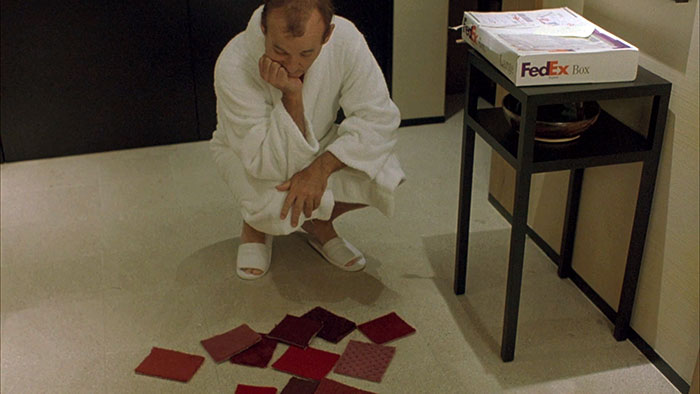
This newfound independence within their marriage might seem like an entirely good and natural thing. However, conducting one’s life without enmeshing it in the lives of loved ones is a quick and easy way to dismiss those people’s importance in one’s life. Bob’s wife sends him endless faxes asking his opinion on which shade is best out of the sample tiles she sends him. According to her, burgundy is best. The mundane has begun to occupy the core of their marriage rather than the periphery.
When one has been in a relationship with another person for a long time, the individuals in that union have a tendency to go into “auto-pilot.” Bob and his wife might be in a stage in their relationship where they each assume everything is fine without bothering to check on their relationship every once in a while to make sure.
When people speak of a “loveless” marriage, they typically mean a union where the frequency and excitement surrounding sexual intimacy has waned. However, Lost in Translation steps away from such an eager assumption. The film makes an important distinction here by making the sexually-motivated scenes devoid of passion or intimacy. There is, of course, the famous “Lip my stockings!” call-girl scene that is far more comical than sexy. When Bob seems to mistakenly find himself in a “gentleman’s club” on a trip with Charlotte’s Japanese friends, he seems uncomfortable and a bit bored. He is eager to leave as soon as Charlotte shows up. Even Bob’s one-night stand with the jazz singer at the bar is not framed as a personal accomplishment or even a pleasurable release. Aside from the fact that Bob is a married man and Charlotte seems so disappointed in him (as though he had personally cheated on her), the sexual distraction does not seem to bring Bob even momentary satisfaction. The audience only sees “the morning after” and the regret and shame that comes with it. Though Bob does not seem to be morally pained by his indiscretion, it does not bring him the positive feelings he might have initially hoped for. True connection with other human being is not as easy to obtain as something one can pay for. One cannot easily escape feelings of desperation and loneliness with temporary distractions.
The relationship Bob shares with his minders during his stay in Tokyo highlights this feeling of being on “auto-pilot.” His team of assistants handle his appointments, his communication, and transportation. Though Bob retains a certain amount of free will as an adult member of society, they have it all under control. Everything is arranged and scheduled for him by underlings. Whenever he can, Bob escapes to join in some hi-jinks with Charlotte like a truant schoolboy. This is the life of a celebrity, where one has the world at one’s fingertips and yet so many personal decisions are being made by other people. This limited sense of agency over oneself can easily bleed into other areas of one’s life. One quickly becomes oblivious to things in one’s surroundings one is no longer forced to pay attention to.
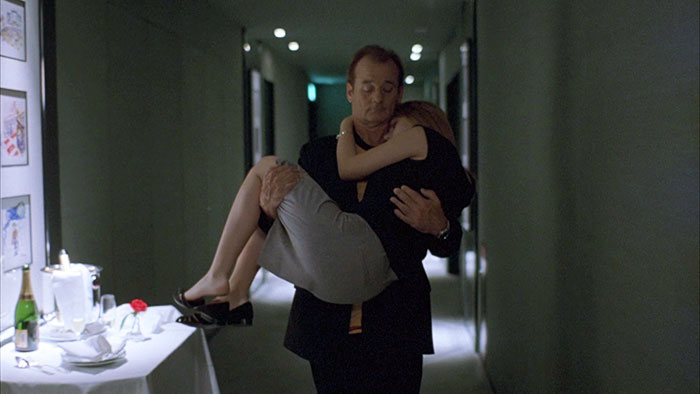
Blindness to one’s environment means relationships suffer as a result, a ripple effect that reverberates throughout Lost in Translation. Being attentive to the hidden pains of others and being willing to endure the mundane to reach the extraordinary is something Bob and Charlotte lack in the relationships they already have when their characters are introduced to the viewer. Examining Bob and Charlotte’s analogous relationships in the film is not to suggest these peripheral relationships pale in comparison to the central relationship of Lost in Translation. These relationships with friends, family members, and spouses are not permanently broken relics Bob and Charlotte should trade in for the “better” connection they share with each other. They merely serve as a reminder of how easily relationships can either wither or mend themselves from moment to moment.
Amplified Backgrounds with Muted Foregrounds
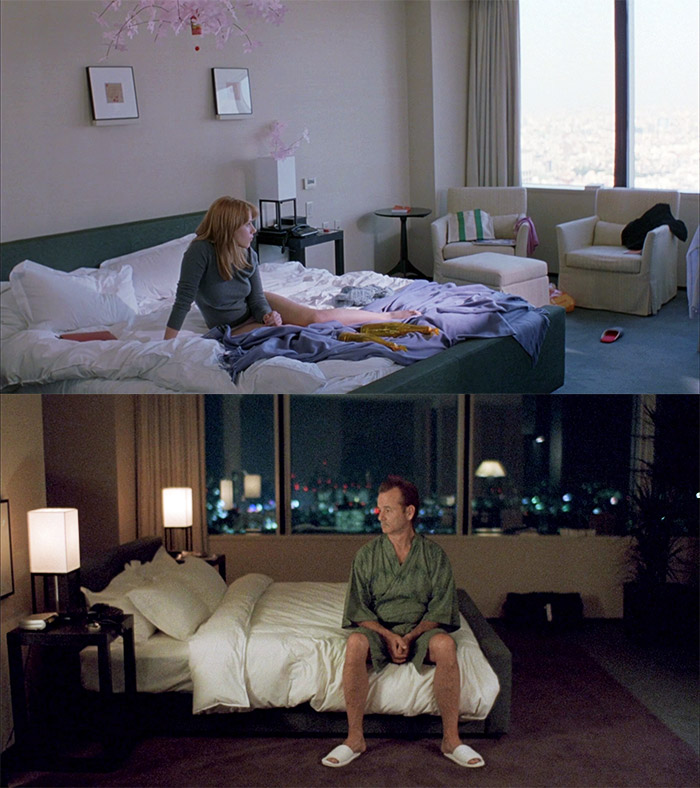
It is important to consider the diegetic sounds of Lost in Translation. These are the sounds that exist within the world of the film. Bob and Charlotte are aware of and witness to this sound design just as the audience is. Oftentimes, Bob and Charlotte are shown alone (or at least lonely, if not physically alone) in their hotel rooms. They are usually unable to sleep. Sounds in these scenes are used to emphasize restlessness, frustration, and dissatisfaction. Snores, alarm clocks, or midnight faxes punctuate the silence. Bob and Charlotte try much of the same things to alleviate their loneliness, whether it’s watching TV or going swimming, to no avail. Through many of these scenes, unobtrusive instrumental music plays in the background.
On his first night in Japan, Bob is shown sitting on the hotel bed by himself as classical music plays lightly in the background. Classical music is used to depict a state of refinement and elegance. Lost in Translation shows the disparity between Bob Harris the movie star and Bob Harris the man. His life is supposed to be glamorous and relaxing since he has already “made it” as a movie star. He is no longer under the heavy glare of camera lights that a younger movie star on the rise would be. He can sit back and enjoy the fruits of a career that allows him to cherry-pick projects and handle low-key jobs like a Japanese whisky advertisement.
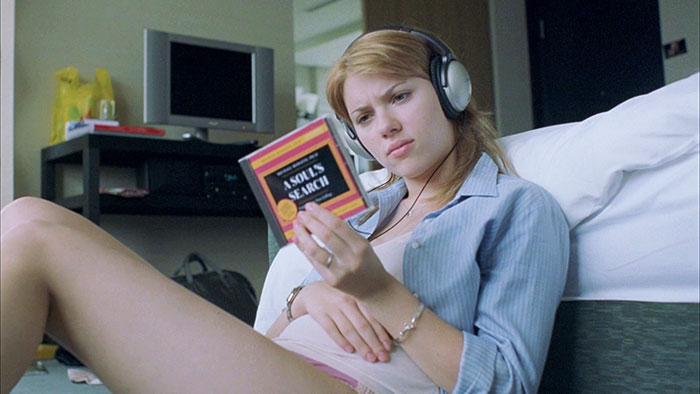
Charlotte, when alone, is at times shown wearing headphones to block out the outside world. She floods her ears with the words of self-help audio recordings. As with most people, none of this advice seems to do her any lasting, substantial good. She gazes wistfully and longingly out of windows in the hopes of finding some sort of clarity she lacks.
Yet in situations such as sharing dinner with John and some of his industry connections, she is mentally removed from the situation. She visibly “zones out” of the conversation, which means the audience will as well. As an observer, Charlotte likes to watch the activity of the world she feels detached from . . . from a relatively safe distance, that is. There are multiple scenes of Charlotte venturing out on her own in an attempt to make herself feel something. If she can’t find that in such a beautiful place as Japan, she feels, then “Where on Earth will I find it?”. All these outside sounds behave as white noise that’s meant to be drowned out so one can focus on what is truly important. What exactly that “important” stuff is, of course, Charlotte is eager to find out.
Lost in Translation chooses not to smother the audience with lots of sound. The sounds largely present in the film belong to neither of the two primary protagonists, Bob and Charlotte. Bob and Charlotte are largely muted by the proliferation of outside noise. This is especially illustrated early on in the film when Bob is in the bar. There is a muffled discussion from two starstruck men who recognize Bob Harris “the movie star.” This conversation between the two men occurs offscreen so neither Bob nor the audience are initially aware of who these voices belong to and where exactly they’re coming from. They are merely strange, unfamiliar voices drifting through the air. As a well-known celebrity, Bob seems to be all too familiar with this type of disturbance. Many people are familiar with the image of him, but few seem to see past that. Charlotte never interacts with him in a way that would suggest he is anything other than a regular human being. Fame is really just amplified applause (or alternatively booing, as the case may be). Real success is a quieter, more stable affair.
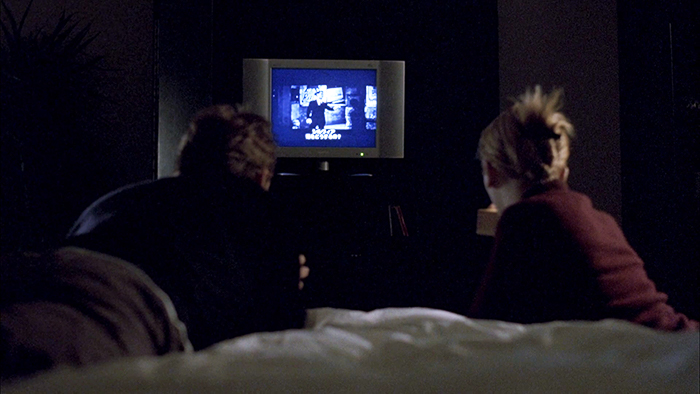
This external noise is punctuated by gaping silences of Bob and Charlotte trying to recover from this onslaught. The outside world seems intent on swallowing them, which is why the relationship they develop with each other is so vital to their survival. Both Bob and Charlotte are shown mindlessly channel-surfing just for some distraction. Sharing a quiet moment at the bar or watching a random movie together serve as a refuge from the cacophony of meaningless noise. It is a way to escape the endless monologues, the feeling of talking to someone else but feeling that each individual involved in the conversation is only turned inward toward themselves.
Intimacy and isolation are indicated by the same methods. The “coziness” of two people sharing the screen can quickly turn into alienation depending on who is within the same frame. Wide-open spaces can be either liberating or make one feel small and insignificant. When “So Into You” is sung live in the background of Bob and Charlotte’s final night together at the bar, the song does not appear to have been picked by request. 4 Diegetic songs such as this emphasize certain thoughts and feelings which could not be expressed with the same potency if they were spoken verbally by the characters themselves. Lost in Translation‘s environment seems to support Bob and Charlotte’s newfound connection even at the same time it conspires to tear them apart.
The Power of Karaoke
Lost in Translation is not a musical. The characters do not spontaneously burst into song, openly sharing with the audience their hopes and fears. Yet the film nevertheless uses the clever vehicle of songs to communicate characters’ thoughts and feelings. Since karaoke is a popular pastime in Japan, it is used as an artistic device in the movie to communicate specific character motivations and drives to the audience.
Charlotte chooses “Brass in Pocket” by The Pretenders, in which she confidently exclaims she’ll “make you notice” anyway she can. 6 Though the song is flirtatious and reveals Charlotte’s fun and carefree side, it also reveals a hidden longing of hers. It demonstrates her need for attention. Not in a cloying, desperate way but simply in a vulnerable, naturally human way. All human beings have an innate need to feel “seen.” This insecurity and longing is present even in someone as seemingly brazen and confident in herself as Charlotte appears to be.
Lost in Translation gives Bob two different karaoke opportunities. He wavers between the songs “(What’s So Funny ‘Bout) Peace, Love and Understanding” by Nick Lowe and “More Than This” by Roxy Music. With the first of the two, Bob engages his comical side. He plays to the others through exaggeration, as if in a self-deprecating tone. And yet the lyrics reveal a hidden insight just as Charlotte’s song does. It’s a song of dissatisfaction and existential misery. The singer feels lost and helpless, but knows that despite how others might belittle these nagging thoughts, his concerns are real and legitimate. 7
The latter, “More Than This,” seems to be directed at Charlotte. Perhaps spurred on by the slower tempo of this song, Bob switches tone and becomes slightly more sincere and serious in his performance as a result. As he periodically glances over in her direction, he sings and it seems as though he and Charlotte are the only the only two people in the karaoke room. It is a hopeful song tinged with a vague melancholy. The singer seems caught unawares by some mysteriously inevitable event or experience. 8 In the case of Bob and Charlotte, their meeting is an uplifting happenstance. Yet, as the song alludes to, there is something sad about their meeting . . . that at some point, it will end.
One must also consider the non-diegetic sounds within the film as an exploration of characters’ interior worlds as well. This is the soundtrack that those who exist within the world of the film are not privy to. Only the audience is invited to listen. This is most emphatic by the film’s end. As Bob and Charlotte separate, “Just Like Honey” by The Jesus and Mary Chain plays in the background. The song describes a girl taking on “half the world” by herself. The singer describes the difficulty of going back to the girl in this song. 9 It perfectly encapsulates both Bob’s decision to see Charlotte off and Charlotte’s uncertain but nevertheless self-assured journey from here on out.
Existential Crisis
Perhaps the reasons for loneliness change, but not the essence of loneliness itself. Young adulthood and middle-age are periods in one’s life where time appears to both slow and get faster. Bob and Charlotte feel stuck while life seems to be hurriedly passing them by, contributing to a feeling of emptiness. When they meet, they are both at a major crossroads in their lives. Bob and Charlotte are lingering at the sidelines, feeling their lives either haven’t started yet or the best of it is already behind them. How does Coppola illustrate this feeling of being in a rut?
The focus here seems to be Charlotte. Middle-age is an oft-treaded ground for existential misery. As a young, educated, and attractive woman Charlotte would appear on a surface-level to be exempt from such periods of restlessness and depression that would more eagerly prey on the mind of someone like Bob. As a woman relatively new to marriage and a recent graduate, she is shown to be drifting directionless through her life. Marriage has not, as is usually promised, made her into a more secure and accomplished version of herself. She finds that she is the same person she always was, but simply with a different change of scenery at every turn.
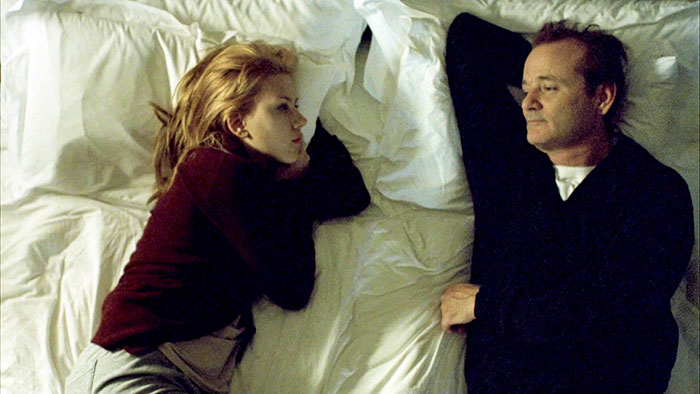
Writing is something she’s pursued, but believes she lacks the talent to do anything serious with it. She expresses she once had an interest in photography as well, a hobby that likely brought her and her husband together in the first place. Yet doesn’t every young twenty-something attempt some “artistic” pictures, claiming to have something important to say? Charlotte feels like a fraud no matter what she does. Nothing sticks for very long. As a former philosophy student, questions about how to live a good life would be important to her. It also makes Charlotte think more deeply about what the universe asks (or perhaps demands) of her that others might not ever think about.
“I tried being a writer, but I hate what I write. And I tried taking pictures, but they’re so mediocre, you know? Every girl goes through a photography phase. You know, like horses?”
Charlotte
Take Two
Bob and Charlotte’s first and last encounters are encapsulated by looks alone. There is a momentary act of recognition. They each acknowledge that the other person exists. As simple as that might seem, it is an experience most people feel is lacking in their lives.
The infamous final scene between Bob and Charlotte culminates in Bob whispering something indistinct into Charlotte’s ear. Audiences have craved finding out what those “secret words” were ever since. Of course, figuring out the precise “words of wisdom,” if that is indeed what they were, is missing the point of that scene.
Their connection is not so they can get the answers to life’s questions from each other. Neither of them seem to have those answers anyway. The brevity of their time together contributes to a greater sense of leniency between them that might not exist otherwise. One is perhaps kinder to those with whom time is brief. Their one major argument in the film does not last long. They cannot afford to waste time over petty disagreements.
Both Bob and Charlotte silently struggle throughout Lost in Translation and yet the relationship they share with each other is not without its own difficulties. They do not escape from dull, monotonous relationships and magically fall into a “perfect” relationship with each other with no undue effort on their part. Their bond requires due attention, hard work, and awkward stumbling over hurdles just as much as any other relationship. It’s about missed chances, mistakes, and messiness. And yet the result of all this effort and imperfection is a beautiful one. Their meeting is a happy accident and that in itself is enough. It can be enough to spur a person on toward the next chapter of one’s life. Being “lost in translation” is not a mistake or linguistic gaffe, but a prerequisite of the human condition.
Much like the film process itself, multiple shots and takes are often needed to effectively execute the full power of a scene. The viewer is often only witness to the end-result, the smoothest sequence of events. Though Lost in Translation embraces the idea of an idealized relationship between two people (with few qualms to damper its hopefulness), it does not tread into this territory lightly. It rejects the feverish rush of a typical “star-crossed” pairing. Lost in Translation provides its two protagonists with an insulated space, where the potential for intimacy between two people takes center stage. It uses silence as a tool for which one may confront one’s sense of alienation and sadness head on, knowing full well there is someone beside you doing the same.
Works Cited
- Lost in Translation. Directed by Sofia Coppola, performances by Bill Murray, Scarlett Johansson, 2003. DVD. ↩
- “Lost in Translation (2003) – ‘Alone in Kyoto’ scene [1080].” YouTube, uploaded by Screen Themes, 3 October 2017. https://www.youtube.com/watch?v=CREQ7yyF-e8&t=1s. ↩
- “Lost in Translation (10/10) Movie CLIP – A Secret Goodbye (2003) HD.” YouTube, uploaded by Movieclips, 30 May 2011, https://www.youtube.com/watch?v=lpOdAHwRnXY. ↩
- Mark Willms. “So Into You.” Release, 2009. Musixmatch, https://www.musixmatch.com/lyrics/Mark-Willms/So-Into-You. ↩
- “Lost in Translation | A Wild Night in Tokyo.” YouTube, uploaded by Universal Pictures, 25 September 2019, https://www.youtube.com/watch?v=XPKO7C543ls. ↩
- The Pretenders. “Brass in Pocket.” Pretenders, 1979. Genius, https://genius.com/Pretenders-brass-in-pocket-lyrics. ↩
- Elvis Costello. “(What’s So Funny ‘Bout) Peace, Love and Understanding. Armed Forces, 1978. Genius, https://genius.com/Elvis-costello-whats-so-funny-bout-peace-love-and-understanding-lyrics ↩
- Roxy Music. “More Than This.” Avalon, 1982. Genius, https://genius.com/Roxy-music-more-than-this-lyrics. ↩
- The Jesus and Mary Chain. “Just Like Honey.” Psychocandy, 1985. Genius, https://genius.com/The-jesus-and-mary-chain-just-like-honey-lyrics. ↩
What do you think? Leave a comment.











I hadn’t ever heard of this film before reading this. But after reading your analysis, I’m certainly intrigued to watch it! If I get around to watching it, it will be interesting to return to your article to better understand what you’re arguing and to see if I picked up on the same things you have.
I really enjoyed this article!
Thank you for your lovely comment, Samantha! I would definitely recommend Lost in Translation. I remember it deeply affected me when I first watched it as a teenager. Even though Charlotte’s character was years older than me, I could already feel I was destined for that same “quarter-life crisis” that overtakes Charlotte’s headspace for much of the film and had a longing for the older “wisdom” of Bob’s character to persevere. It deeply moved me. If you do eventually get around to watching the film, I’d be interested to hear your thoughts!
A fine analysis and a good read. Thank you. That final goodbye scene between Bob and Charlotte, in which we never hear what Bob whispers in Charlotte’s ear, is, for me at least, the most intimate moment in the film. It works beautifully. It’s ‘their moment’ and and I think it’s particularly poignant that it happens at the end of their story.
Apparently Coppola made ‘Lost in Translation’ after the break-up of her marriage to Spike Jonze and drew on that experience when writing for Bob and Charlotte. Jonze made ‘Her’ (2013), which, in a way, can be read as his response to ‘Lost in Translation.’ I’d recommend ‘Her’ for anyone who has seen or plans to see ‘Lost in Translation’ as it can be viewed as a companion piece.
Thank you, Amyus! Yes, I just learned about the connection to Spike Jonze’s Her only recently. And I agree, anyone who likes Lost in Translation should definitely check out that film as a companion piece. Even though her role is a minor one, I particularly loved Amy Adams’s role (she always manages to be a scene-stealer no matter what) in Her as one of Theodore’s ex-girlfriends and friends. Yes, I also love that goodbye scene in Lost in Translation! It’s almost a reinterpretation of Charlotte’s crying scene on the phone with her friend. Except here, her pain is recognized and she’s comforted (without having to do the job entirely on her own like she had to after the phone call).
Always loved the vibe it captures. Having since lived abroad and felt that aimless wandering it’s not only a great movie now but helps bring up those old memories and emotions.
It’s my personal favourite – not a wasted line of dialogue or a wasted shot.
The light touches of the film are fantastic and the way it is almost genreless is astounding and supremely frustrating when someone asks ‘what kind of film is it?’
When I first watched the film I had some doubts because I’ve never been a fan of Scarlet Johansson. But there’s something about people analyzing films that make me watch films with fresh eyes. So because of this post, I might rewatch the film and gain new perspectives. Thank you so much!
You’re very welcome, John! Yeah, whether it’s movies or books or music . . . sometimes you need repeated viewings to gain more and more insights into them. Sometimes it can change our opinions entirely, because we change just as much and just as often as the art does.
I do think it’s a film that needs to be seen a second time. I’ve talked to many people who didn’t like it the first time, including myself.
I shouldn’t say I didn’t like it the first time, but it didn’t resonate with me. I think getting a few more years under my belt, and being a bit more experienced with the ups and downs of relationships, helped a lot.
Thanks for covering my favorite movie. Sofia Coppola’s script is brilliant, because it’s an honest portrayal of two abstract thinkers who are stuck in relationships with concrete-thinking spouses. Charlotte is an Idealist, married to an Artisan photographer. Bob is Rational, with a Guardian wife. The characters are textbook examples from the Myers-Briggs Type Indicator and/or Keirsey Temperament Sorter. Their temperaments are consistent and believable. I don’t know if it was intentional on Coppola’s part, but I thought it was genius to set the picture in Japan, with it’s shorter population. Abstract thinkers are rare, and operate at a higher level than the concrete thinking masses.
What an interesting way of looking at the film! Looking at it through the lens of the Myers-Briggs Type Indicator and/or Keirsey Temperament Sorter, it seems even clearer now why certain characters have greater compatibility with each other than others. Thanks for the comment!
It captures the absurdity and melancholy of jet lag mixed with hotel bars in so-expensive-only- rich-assholes-and- business-travelers-can -afford-it exceptionally well.
I love this movie.
I saw this film in 2003 as my relationship with my girlfriend was ending. The film was showing at the local film club at the local theatre where she worked. She was ushering that evening & things were horribly awkward between us. The thing was, I was completely in love with her & she was pulling away.
Watching Lost in Translation that evening saved me, it was the shoulder to cry on, a cathartic release I’d been craving for months. When the film ended, I told my girlfriend to collect her things that weekend & go be who she needed to be.
I bought saki & a pocket of smokes on the way home & spend the rest of the night listening to The Pretenders & Roxy Music & I never looked back.
And to this day I never have.
That film has a special place in my heart & is a film I absolutely adore. Peace.
LIT is a beautifully balanced study of loneliness within a relationship, and it has Bill Murray in it. What’s not to like?
I heard of Lost of Translation before, but didn’t know exactly what it was about. Your article now makes me more curious to see it. Also, great commentary/analysis on loneliness and isolation!
Thank you! Loneliness and isolation is sadly such a relevant topic nowadays.
A good essay about a movie I keep putting off wanting to see. I think I’ll finally see it.
I truly love this film. For me, it is about marriage as the definition of your life and who you are. Charlotte and Bob are at opposite ends of the relationship timeline; she is newly married and Bob, who we are led to believe through the telephone conversations with his wife, has been married a long time. They meet in a foreign landscape – a sleepless confusion where a sense of normality is in suspension, comically illustrated by Bob’s hilarious whisky photo-shoot. It’s a fairytale where two wholly different characters find a bond in their displacement and get to play with aspects of their personalities that are possibly restrained in their everyday lives – the wee hours drunken karaoke scene in the backstreet netherlands of Tokyo is a nice hint of these little fantasies that may exist in all of us. It’s a lovely film; arguably the best rom-com since Annie Hall.
Can’t argue with that… also love this film.
It’s a fantastic film and Scarlett Johansson – and Bill Murray – are basically perfect in it.
A lot of people seem to be saying that Charlotte isn’t nice, and is self-absorbed. Well, you probably were too in your early 20’s. Bill Murray’s character is hardly perfect – he is cheating and disinterested in his wife – but it’s the imperfections that make them believable characters.
I also think Scarlett’s low key, occasionally slightly absent acting persona helped in the role. Another star of her age might well have tried to be more engaging, sassy or – god forbid – kooky, and it would have killed the chemistry with Bill Murray, and therefore the film, stone dead.
The part I like most is the background noise. It’s like a soundtrack of silence. It is how Tokyo appears to me, even in the middle of Shibuya junction, there is a silence. It’s the most populated place on the planet and there is no anger, no rage. It perfectly suits the quietness of the characters contemplating their own demise.
When Charlotte goes to Kyoto on the Shinkansen and listens to the tour through headphones, when she’s at the party, when Murray is in the bar and on set- it’s all shot with a silence, and doesn’t suck up to the image of Tokyo being crazy.
I really miss Shibuya. After work I’d fairly often meet people at some place or other in Shibuya, and waiting at the crossing for the lights to change, I could feel all the stodginess of work draining out of me and the energy of the place seeping in. By the time I got to the other side I’d feel as if I’d just woken up. Can’t think of anywhere I’d get the same feeling in Dublin.
One of my favourite films. I saw it when it came out and I was 19, in ten years I’ve never tired of repeat viewings. Scarelett’s best film in my opinion, in the final scene when she has tears in her eyes, then Just Like Honey kicks in…sublime.
Probably one of the shittest scenes in all of my favourite movies. And LIT probably is my favourite film, but man, that scene was not funny at all… it fell to boring “wow, Asians swap l’s and r’s!” stereotypes which seems a bit beneath a movie that’s, essentially, not cheap and dumb.
It also helped warp the way they tried to market this film too. I got into this film through the poster of Bill Murray sitting in his room, looking deadpan, with this weirdly Wes Anderson atmosphere. Then the ads showed it as trying to be a rom-com or some kind of comedy. I don’t know but that always irked me – misrepresenting a movie that’s all about the provoking of meaningful but impossible to represent feelings, thoughts, motives, and atmospheres.
Yep – it’s the crack in her voice when she says ‘bye’. I love it.
I remember watching this on DVD years ago with a now ex. I was bowled over, asked her for her thoughts. She said it was okay, blatantly didn’t like it. Gave me this dread feeling in my poetic soul that she had no romance in her and wondered if I should end it. I didn’t, and that was a bad mistake. Always give a new date the Lost in Translation test. Best life advice I can give.
Interesting.
I was with my ex for 5 years, I thought she was definitely the girl I would marry. So much in common, so many good times, loved her so very, very much…
But yeah, early on during our courtship I thought I’d watch Lost in Translation with her because: a) I love it and b) it was either that or Star Trek VI The Undiscovered Country.
As the film ends and I’m trying to hide the fact that there are tears rolling down my face, she pipes up with something on the lines of “Is that it? I thought you said this film was good/romantic/whatever”
I should have known then. I should have known then that she was capable of walking away, deserting me, meeting someone new and never giving me a second thought.
I’m adopting the above Lost in Translation test. Words to live by.
Genuinely. If your partner isn’t emotionally/romantically moved by something that emotionally/romantically moves you then I would say compatibility might end up being an issue.
I just wish I’d learnt this when I was in my 20s. Or even early 30s!
i remember seeing this at the cinema with my friend. Two people walked out during it. At the end my friend said “we never see good films” – but i had loved it!
I fell in love with Scarlett here – the way she says ‘hello’ *dies*
First time I saw it I loved it, second time loathed it, third time loved it again, fourth time…you get the drift…
Your analysis of “Lost In Translation” is spot on. I’m use to seeing Bill Murray play a comedic role, so it was interesting to see him step outside of his typecasted norm in an attempt to play a more serious character, which I felt he did successfully. One point to made about this film was that sound is arguably the most crucial element, for it helps establish setting and also emphasizes characterization.
Specifically, how the dialogue reflects a characters internal feelings and conflicts, such as Bill Murray’s characters feeling of depression before he meets Charlotte. Similarly, one character that stood out to me, although she played a minor role in the film, was Anna Faris’ character, Kelly. Despite not being involved too much in the plot, and being briefly introduced to us, we managed to still get a fairly good sense of her personality. Through the quirky, flirty dialogue used by Kelly, the audience understands that she is a ditzy, bubbly, young starlet by the way she talks to Charlotte’s fiancé.
Not only does the dialogue assist in the development of Kelly’s personality, but it also creates dynamic between her and Charlotte, for we begin to get the sense that Charlotte is perhaps jealous of Kelly’s prior relationship with Charlotte’s fiancé. One of the final points you made was the claim that sound effects were the most prevalent use of sound throughout the film, and I have to agree. During the midterm, we screened the final scene from this film where Bill Murray’s character is departing for the airport, but spots Charlotte walking down a busy street. He stops the car, and as soon as he gets out, we are overwhelmed with the sounds of the hustle and bustle of the street – car horns, people talking, traffic speeding by – which furthers the sense of being an outsider in a foreign world.
The sound effects engulf Bill Murray’s character and Charlotte, however also provides a stark contrast to their internal feelings at this point in the film, because despite being alone in a strange place, they embrace, and we recognize that they have each other for companionship.
Love the film, just wish they removed the scene with the woman coming to Bob’s room and demanding he rip her tights. Would have lost nothing if removed and comes across as pointless and a bit racist when left in.
She has an accent that causes some unintended homonyms. I think thats pretty funny. And yes, it does have some meaning to the movie, as Murray’s character is finding alienation even in the simple act of hiring an escort.
I’d place Lost In Translation along other films where two people are able to establish a bond that goes beyond social norms and rules: Last Tango In Paris, Amelie, Lolita… all very different but have that aspect to them
A lot of films out there do indeed give the impression that relationships need to follow certain rules established by society in order to be fulfilling and successful. I wouldn’t say that this is Hollywood setting these rules but that Western societies generally impose that idea.
We have very clear ideas imposed by society as to what is normal/acceptable and what is weird or creepy.
What a lot of these views miss entirely is how emotions and feelings don’t follow social rules.
Another article about some of my favorite topics–language, culture shock, and socialization in media. Nice work!
Always praised this film. So beige and silent. It truly is how Tokyo is when you’re here. So much beige, conformity and gathered groups of people bowing when they hand over their meishi. This is exactly how it is. Endless talking about details, endless nodding and bowing. None of it meaning anything except honour and dutiful obligation to manners.
The Japanese in this film are not racially profiled, which I like. The show host is not overdone, and the film director and his assistant are as they would be here. I like all that- nothing is made of the race, just the story.
I hate Johanssen in it, but she’s not a good actress and suits the self obsession of her part. I like how Murray doesn’t really seem to love her, just needs a bit of attention.
I showed this film to my partner to persuade her to come and live in Japan with me for a year. It worked and we still watch it now and again
I know Tokyo is supposed this strange and alienating world in the movie, but its that feeling of being so very far away from home and surrounding by different customs and ever being treated as the foreigner (actually, treated as a novelty for my pretty, redhead partner in the mid-size town we ended up in), that keeps it as our favourite city, despite having had the luck to visit many other since that time.
The trips to Tokyo were a time when I could happily just wander the streets getting lost as the buzz, architecture and cultural oddities happened upon were as much as a draw as any destination I planned out. Amsterdam gives me a similar feeling.
You see Charlotte wandering on her own without Bill, and you see pleasing mix of curiosity and confusion on her face as she gets lost.
I always think when i watch the movie, that she will look back at this time of being without a clear path in life, and the freedom from responsibility that come with it, as some of her fondest memories.
I’ve enjoyed the freshness of this writing more than I did the film (or my recollection of it). Definitely, keep writing!
My favorite love story by far. I don’t really see it as a romance, just a love story. Her, eternal sunshine of the spotless mind several of PTA movies (Magnolia, Punch Drunk Love and now Phantom Thread). I pretty much love everything Bill Murray is in, but this is his best imo.
I spotted this film randomly on Netflix last month. I barely watched it while doing something else but its magical vibe even grabbed my attention from afar. I really need to get back and watch the whole thing though. It made me strangely emotional just by its atmosphere.
Interesting analysis. This film has definitely grown on me. I used to dislike it but now every time I watch it, it feels so initimate and pure. I really love it.
I love how this lil indie film that took 27 days to shoot, had a teeny budget, and a relatively unknown female lead at the time still has people analyzing and dissecting it to this day. It’s amazing. 💛
I thoroughly disliked this movie when I originally watched it. I’ve only seen it that one time. I felt like nothing happened, and it’s just a collection of random scenes. I then heard that Sofia Coppola didn’t really work from a script, and it was just her filming whatever she felt like. It made sense, and my opinion that it was shit felt justified. I’m going on vacation out of country later today, but after everyone saying their ‘years later’ rewatch caused them to LOVE it, I’ll give it another try when I get back.
Believe it or not, it took me quite long to figure out what this movie was about. I remember I watched it 5 times and then it struck me – this guys fell in love! I know I was crazy because my conception of love was – Young beauty falls in love with young prince, and this whole conception was so out of my world that – my mind just couldnt process it. And this is how I get a little bit older, a little bit wiser. Still I am a fool today 🙂
I first watched this film when it was released then on calling into a charity shop yesterday I saw it and bought it. Watched it last night. The film can ‘mean’ something to everyone. Personally (whether the characters are selfish or not) it’s a sad film but at the same time uplifting in that love is out there and sometimes we do not have to go looking for it or advertise ourselves for it….it will happen at some point in our lives whether in Tokyo or in the local cafe.
This is one of those movies where the first time I watched it, I only “liked” it but didn’t feel it was as great as everyone said it was. Yet, I keep having this urge to revisit it. When I did, I slowly came to admire it. It seems that the more I keep re-watching it, the more I like it just slightly more than the first viewing. This is a SLOW movie, which I guess was the main problem for me. It’s strange cause I usually love slow paced movies like Drive and Only God Forgives. I guess the difference is that this, just like Tree of Life, has a meditative slow paced, while Drive and Only God Forgives are slow paced but also has something interesting happen every moment or two.
I lived in korea for 2 years in 1990’s, my experience there is exactly how LIT ended up. a part of me is still hanging out somewhere in Seoul and I think about my time there (albeit less and less every year). it was a happy time where I first found true love, strong friendships and lasting memories, even though I was lost in my life when I arrived, not knowing anyone.
This has been one of the most beautiful films I’ve ever seen…the ending will mark you forever. As a Gay man, I’ve had these types of melancholy situations in my life, so it’s something I firmly relate to. Thanks Sophia Coppola Ford.
This is one of my favorite movies where I didn’t understand when I watched it young, but completely understood it with some life experiences down the road. I miss the time I spent in Japan
I have spent a huge amount of time in Japan and especially Tokyo. I think the film captured the feeling of being alone in a strange city beautifully.
Alone in Kyoto really is the signature moment for this film. Where the otherworldly nature of Japan expresses itself and the two realise that they almost need each other in this bizarre land.
God damn I do love this film.
Great use of music by Sofia Coppola and music supervisor Kevin Shields. All the music feels unobtrusive and appropriate to the scene it’s used in, but has it’s own identity and aesthetic.
Really nice article, I’ve been wanting to see Lost in Translation for quite a while being interested in Sofia Coppola’s films and usually liking the whole self-discovery thing. I recently finally picked up the DVD and tonight, I am going to watch it.
The songs they pick at Karaoke are significant, and describe their situation in life. He picks Roxy Music’s More Than This (no, there’s nothing… more than this), and she picks The Pretenders’ Brass in Pocket (I’m special, so special, I gotta have some of your attention give it to me). They’re both going through an existentialist crisis of sorts, he needs to find meaning now his career is almost over and kids are grown, and she needs to find meaning outside her marriage.
Don’t forget the other one he picks, Elvis Costello’s “What’s So Funny (About Peace, Love & Understanding)?”.
And their local friend? “God Save The Queen (And Her Fascist Regime)”!
“Lost In Translation” is in my top five of that decade, along with “The Lives Of Others”, “The New World”, “Children Of Men” and “Battle Royale”.
This movie is magical.
There’s nothing quite like this movie. I’ve never seen anything like it since. And it reminds me of an earlier time in the 2000s when there seemed to be more possibilities, and fast-forwarding to now it doesn’t seem as exciting, or interesting as then, not to sound like a downer. It also could be Japanese culture that is just rich and full that’s missing from ours.
This film is all about the complete inability of Americans to understand other cultures.
GREAT post. It’s a film of quietness celebrated and utterly beguiling.
I love this movie. Is one of those at the top of my list. One of those that mark a before and after watching them. One that changes the view you have about anything in particular and help you move forward in some way. And I don’t have many on that list, Der siebente Kontinent is the other and would struggle to think of a 3rd one. Not many left me with something meaningful and powerful to take away with me after watching them.
That was a BEAUTIFUL interpretation of this movie!
Lost in translation has some of the most beautiful soundtracks.
I like this movie quite a bit, but i took a much more cynical approach. I didn’t buy that they were in love at all, I thought they both just were desperate for a normal american interaction and relationship. Obviously it progressed and they developed feelings for each other, but it was the kind of think that could ever only work in the bizarre environment they shared. Almost like it was a relationship developed at a summer camp or on a cruise or something. Take them out of that and back to regular life in America and you know it doesn’t work out, similar to the ending of the Graduate.
I heard about this movie long before but didn’t get the time to watch it. Your article made me realize that I missed a masterpiece. Now I want to watch every scene that you recreated with your writing.
Thank you, very nicely written piece, really enjoyed it! 🙂
The soundtrack, like all Sofia Copolla films, is amazing. It is what makes the film what it is. It sets the tone and mood. The endings with the beats of “Just like honey” is its finest moment.
I absolutely love this film. Is unpretentious and sweet.
I walked out of this movie when it came out in the cinema (I was only about 16) and then years later I watched in again on a plane when I was traveling for work and drinking a lot. The whole thing made so much more sense with older eyes and it’s been one of my favorite movies ever since.
The scene where they fall asleep together is one of the most beautiful and tender things I’ve ever seen.
I loved the strip club scene. It was like the film was dissing the usual conventions of sex in rom coms, in a lavishly tongue in cheek fashion. And the music is simply hilarious, “Suckin’ on ma titties!!!”, lmao
Thank you so much for sharing this, I enjoyed the movie very much, but this analysis goes deeper and makes my appreciation for the film even greater. Lovely read 🙂
You’re welcome, Caroline! I’m glad you enjoyed it.
I loved this immediately at age 21 when it came out. I’ve watched it probably once every 5 years or so. I watched it this week and at age 38, it spoke to me in so many different ways. My love for it/understanding of it has evolved just like myself over the years. So beautiful.
A good analysis of Bill and Charlotte’s “silent” relationship! It’s true that the best moments in any relationship, romantic or not, is the mutual understanding without any utterances. Apart from certain racial elements in the film (I am Asian), I love the work.
One of my favorite movies
incredible analysis, thorough and encapsulates everything I thought when watching this movie but couldn’t put down into words
Thank you so much for your kind words!
Great read – will definitely have to rewatch again! Watched it when I was 16, excited to watch with a new perspective
Such a great read, thank you! I think the use of silence speaks to the film’s focus on seeing. Bob and Charlotte “see” each other in a way that their spouses don’t see them and in a way they don’t see their spouses. The silence emphasizes the connection they foster through body language and shared culture alone. It seems less about their shared language and more about the connection they create based on shared American cultural norms that differ in some ways from Japanese cultural norms. The film’s use of both diegetic and non-diegetic music is also interesting, with an extensive pop soundtrack in addition to karaoke scenes. Coppola seems to place the audience in the position of the characters at certain moments, while also squarely reminding the viewer of their external position to the connection between Bob and Charlotte at other moments.
Thank you for the lovely comment, kkenny! Yes, I completely agree with your observations about “seeing” and feeling “seen” (which is an experience encapsulated by a type of reverential silence) by the other as well as the difference in cultural norms. “Seeing” and “feeling seen” by another is a truly powerful and life-affirming thing.
Great discussion of a great film… I think part of why the ending hits me so hard is how strenuously Coppola avoids over-the-top use of sound before that point… it’s just a wonderful scene
That’s a great point! The periodic absence of sound heightens the emotional profundity of a scene. I agree . . . that ending is simply beautiful.
This is an insightful analysis. I especially enjoyed the way you demonstrate how silence is not a lack of communication, it is a type of communication. I also appreciated your description of intimate silences between Charlotte and Bob and even the way the muted colors are a kind of silence in some scenes.
I love the way the film captured the alienation of traveling to a country in which you don’t speak the language. Both characters seem to be trying to reinvent or renew their own identities, but they haven’t quite developed the psychological language to accomplish that yet.
Thank you so much for your thoughtful comments. Yes, I completely agree. Silence doesn’t necessarily signal a lack of something, just as much as two people talking doesn’t mean they are actually communicating with each other. It can be profound or empty depending on the context. The alienation they feel about being in a foreign country forces both Bob and Charlotte to reevaluate feelings and thoughts they’ve probably been harboring for a long time but never realized were there until now.
I’ve always wanted to watch this film but haven’t more some reason. Great article! I think I’ll go watch it now.
I recently rewatched this film, and it is as excellent as I remember it. Sofia Coppola is a great director, and she made one of the best films of the 2000s.
This movie was on my watchlist for a while, so when I finally saw it I was very excited. Although I should’ve anticipated the awkward age gap between the lovers, I still found it a little awkward personally. I was holding out for a deep friendship between the two characters, and I was left hiding under my covers by the end of it. Nevertheless, Sofia Coppola proves her maturity and style through the film, and that is something everyone can appreciate.
This is a beautiful film, and I love the way this article is divided into pieces and gives a detailed analysis!
Thank you, yakmendez!